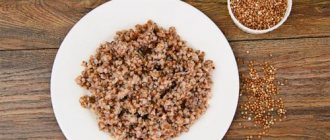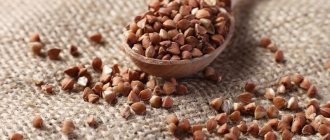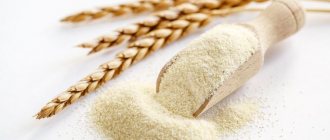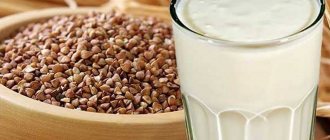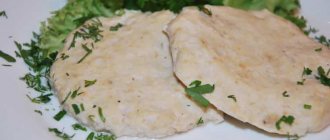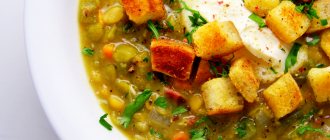What are the benefits of buckwheat porridge?
Photo: Pixabay
Buckwheat is rich in essential amino acids and complex carbohydrates for the body. The latter help fill you up and contribute to the proper functioning of the gastrointestinal tract. Thanks to the content of flavonoids, quercetin and rutin, buckwheat porridge strengthens the walls of blood vessels and is a natural medicine for the prevention of diseases of the cardiovascular system. Buckwheat can also increase the level of hemoglobin in the blood and help lower blood pressure. Due to its high protein content and low calorie content, buckwheat is useful for dieting - it gives you a feeling of fullness for a long time, and you don’t want to eat longer.
In addition, buckwheat:
- Reduces the level of “bad” cholesterol;
- stimulates digestive processes;
- cleanses of toxins and impurities;
- supports the full functioning of the nervous and endocrine systems;
- improves sleep quality;
- normalizes metabolism and blood pressure;
- increases immunity;
- eliminates signs of chronic fatigue and the effects of stress;
- improves brain activity;
- useful for pregnant women due to the presence of folic acid, which takes an active part in the development of the fetus.
Mineral composition of buckwheat:
- iron,
- manganese,
- magnesium,
- phosphorus,
- potassium,
- calcium,
- silicon,
- Vitamins: A, B1, B2, B3, B6, B9, E, H, PP and choline.
This is one of the reasons to include buckwheat porridge in your daily diet. Scientists recommend regularly consuming buckwheat for vegetarians.
Content of useful elements in buckwheat
Table: content of microelements and vitamins per 100 grams of dry buckwheat
| Name | Content | Daily requirement % |
| Co (cobalt) | 3.1 mcg | 0.31 |
| PP (niacin) | 4.19 mg | 17 |
| K (potassium) | 380 mg | 19 |
| Ca (calcium) | 20 mg | 2 |
| Mg (magnesium) | 200 mg | 57 |
| B9 (folic acid) | 32 mcg | 3.2 |
| B1 (thiamine) | 0.43 mg | 29 |
| B6 (pyridoxine) | 0.4 mg | 20 |
| Fe (iron) | 6.6 mg | 44 |
| Cu (copper) | 0.64 mg | 43 |
| B2 (riboflavin) | 0.2 mg | 12 |
Buckwheat also contains manganese, chromium, silicon and zinc.
Who shouldn't eat buckwheat?
Despite the fact that buckwheat contains many useful substances, not everyone can consume it. Experts have told who should not eat buckwheat.
Contraindications to eating buckwheat porridge:
- it should not be included in the diet of people who have increased blood clotting;
- buckwheat is contraindicated for diabetics and people with kidney failure;
- The harm of porridge can be felt by hypertensive patients. Rutin contained in buckwheat dilates blood vessels, which can lead to an attack;
- for diseases of the gastrointestinal tract, it is better to discuss the possibility of including buckwheat in your diet with your doctor first;
- Buckwheat contains a lot of protein, which can cause allergies.
The effect of buckwheat on gastritis and pancreatitis
Photo: Pixabay
For people with diseases of the gastrointestinal tract, buckwheat is a salvation: it is healthy, does not injure or irritate the esophagus, improves intestinal function, and is rich in vitamins and minerals necessary for the body. A buckwheat diet for stomach diseases can be long-lasting without complications or side effects, and a minimal list of contraindications allows you to include buckwheat in the menu of people of all ages.
Chemical composition of buckwheat per 100 grams
100 g of buckwheat contains:
- vitamin B1 - 28.7% of the norm;
- B2 - 11.1%;
- B6 - 20%;
- N - 20%;
- RR - 36%;
- potassium - 15.2%;
- silicon - 270%;
- magnesium - 50%;
- phosphorus - 37.3%;
- iron - 37.2%;
- cobalt -31%;
- manganese - 78%;
- copper - 64%;
- molybdenum - 49.1%;
- zinc - 17.1%.
Content of vitamins and minerals per 100 g of product:
- A - 2 mcg;
- beta-carotene - 0.01 mg;
- B1, thiamine - 0.43 mg;
- B2, riboflavin - 0.2 mg;
- B3, niacin - 4.2 mg;
- B4, choline - 54.2 mg;
- B5, pantothenic acid - 0.44 mg;
- B6, pyridoxine - 0.4 mg;
- B9, folate - 32 mcg;
- E, alpha-tocopherol - 0.8 mg;
- H, biotin - 10 mcg;
- K, phylloquinone - 7 mcg;
- RR - 7.2 mg;
- aluminum - 33.3 μg;
- boron - 350 mcg;
- vanadium - 170 mcg;
- iron - 6.7 mg;
- iodine - 3.3 mcg;
- cobalt - 3.1 mcg;
- lithium - 4.2 mcg;
- manganese - 1.56 mg;
- copper - 640 mcg;
- molybdenum - 34.4 mcg;
- nickel - 10.1 μg;
- rubidium - 52.5 mcg;
- selenium - 5.7 mcg;
- strontium - 304 mcg;
- titanium - 33 mcg;
- fluorine - 23 mcg;
- chromium - 4 mcg;
- zinc - 2.05 mg;
- zirconium - 35 mcg.
Top 4 options for preparing buckwheat porridge
In addition to being incredibly healthy, buckwheat is also very tasty. From this grain you can prepare many interesting dishes, the preparation of which will require a minimum of time and effort. We'll tell you about four ways to cook buckwheat porridge.
Method number 1: How to cook buckwheat in water
Photo: Wikimedia Commons
Cooking buckwheat in water is quick and easy. To make the porridge really tasty, you need to do the following:
- Sort through the cereal. Buckwheat contains black grains and some foreign debris. Then the buckwheat should be washed under running water several times.
- Heat the buckwheat in a frying pan. This is not necessary, but if you want to prepare truly aromatic and crumbly porridge, then do not skip this point. “Fry” the buckwheat until a slight aroma is felt - at this stage the pan must be removed from the heat, otherwise the future porridge will burn.
- If you wish and have free time, you can soak buckwheat in water for a couple of hours before cooking. You can do this directly in the pan in which you are going to later prepare the planned dish.
- If you soaked buckwheat in advance, then add water to it so that it covers the grain, and put it on low heat. If not, then boil water, the volume of which should be 2 times the volume of buckwheat, add salt and pour in the cereal. You need to cook buckwheat for 15 minutes if you soaked it in advance, and 25-30 minutes if not.
- Add oil and seasonings. Add a little vegetable oil and any seasonings you wish to the future porridge. Buckwheat goes well in taste with Provençal herbs, dried garlic and a soup dressing made from dry vegetables and spices. Add salt to taste.
Method No. 2: How to cook buckwheat porridge with milk
Photo: vecteezy.com
Buckwheat porridge with milk is a simple and healthy dish that almost everyone likes. This option is ideal for breakfast. To prepare milk porridge you will need the following products:
- 1 cup buckwheat;
- 5 glasses of milk;
- 2 tablespoons sugar;
- Butter;
- Vanillin;
- Salt.
How to cook buckwheat with milk:
Pour milk into a saucepan and place on fire. Bring milk to a boil, add vanillin, salt and sugar. Then add the previously prepared buckwheat. After this, stir it and let it boil again. Now you can add butter to the porridge, reduce the heat to low, and cover the pan with a lid. During the cooking process, do not forget to constantly stir the porridge so that a milky film does not form. Cook the porridge for 30-40 minutes. After cooking, the porridge can be left covered for another 10 minutes.
Calorie content, dietary fat and glycemic index
Buckwheat has a low calorie content - 308 kcal per 100 g of dry product. When cooked it is even less - 83.7 kcal. After cooking, the ratio of proteins, fats and carbohydrates changes.
| Nutrient | Dry buckwheat | Boiled buckwheat |
| Squirrels | 12.6 g | 3.6 g |
| Fats | 3.3 g | 0.9 g |
| Carbohydrates | 57.1 g | 16.2 g |
| Alimentary fiber | 11.3 g | 3.2 g |
| Water | 14 g | 74,7 |
| Ash | 1.7 g | 1.259 g |
The glycemic index is 55 units out of 100. This means that the blood sugar level after eating buckwheat rises gradually, so nutrients are fully absorbed and fat is not deposited.
The nutritional value of each dish is different. Buckwheat cooked with different types of meat, as well as in different ways, has different indicators.
Buckwheat porridge with beef stew is rich in vitamin A (22.4%) and beta-carotene (24.2%).
Per 100 g:
- calories - 138.5 kcal;
- proteins - 7.4 g;
- fat - 5.6 g;
- carbohydrates - 15.8 g;
- organic acids - 0.1 g;
- dietary fiber - 0.6 g;
- water - 47.3 g;
- ash - 0.213 g.
The calorie content of buckwheat with minced meat is 141.8 kcal.
Compound:
- proteins - 7.2 g;
- fat - 7.2 g;
- carbohydrates - 12.4 g;
- dietary fiber - 0 g;
- water - 0 g.
100 g of buckwheat with blood sausage contains 274 kcal. This is twice as high as in porridge with stewed meat or minced meat.
Compound:
- proteins - 9 g;
- fats - 19.5 g;
- carbohydrates - 14.5 g;
- dietary fiber - 0 g;
- water - 0 g.
The beneficial properties of buckwheat with turkey include a high content of vitamin A (21.2%), beta-carotene (22.9%), silicon (42.9%), manganese (13.6%), copper (11.1 %).
Compound:
- calories - 100.3 kcal;
- proteins - 9.4 g;
- fats - 2.1 g;
- carbohydrates - 10.2 g;
- dietary fiber - 2.3 g;
- water - 46 g.
The energy value of buckwheat with chicken is 164.6 kcal.
Compound:
- proteins - 10.4 g;
- fats - 6.2 g;
- carbohydrates - 16.9 g;
- dietary fiber - 1.9 g;
- water - 0 g.
The number of calories in 100 g of buckwheat with pork is 141.5 kcal.
Compound:
- proteins - 9.2 g;
- fats - 4.8 g;
- carbohydrates - 15.4 g;
- dietary fiber - 3.2 g;
- water - 66 g.
The energy value is 160 kcal.
Compound:
- proteins - 17.2 g;
- fats - 6.9 g;
- carbohydrates - 7.3 g;
- dietary fiber - 1.4 g;
- water - 67 g.
Contents per 100 g serving:
- calories - 130 kcal;
- proteins - 2.1 g;
- fat - 6.5 g;
- carbohydrates - 13.3 g.
Method number 3: How to cook buckwheat porridge with vegetables
Photo: Wikimedia Commons
This version of the dish is very popular among vegetarians. Buckwheat with vegetables is also suitable for those who are fasting. It can act as a side dish or a main dish. For cooking you will need the following products:
- 2 glasses water
- 1 cup buckwheat
- 1 piece (large) tomato
- 1 piece onion
- vegetable oil
- 1pc carrot
- salt
- ground pepper mixture
- 1pc bell pepper
With stew
| Name | Quantity | fats | carbohydrates | squirrels | Total kcal |
| Buckwheat (2.5 cups) | 500 gr | 13 | 340 | 63 | 1729 |
| Stew (1 can) | 400 gr | 69.6 | 56.4 | 852 | |
| Water (5 glasses) | 1.2 l | ||||
| Onion (2 pcs) | 200 gr | 20.8 | 2.8 | 96 | |
| Carrots (1 piece) | 100 gr | 0.1 | 6.9 | 1.3 | 35 |
| Volume. pasta (3 tablespoons) | 100 gr | 1.5 | 16.7 | 5.6 | 104 |
| Butter (3 tablespoons) | 100 gr | 82.5 | 0.8 | 0.5 | 744 |
| Total calories in 9 servings/250 grams | 2350 gr | 1500 | 1540 | 519 | 3560 |
100 grams of buckwheat with stew contains 151 kcal.
Stewed dishes are universal, easy to prepare and valued for their high taste.
How to cook buckwheat with vegetables:
- Cut the tomatoes, onions and bell peppers into small cubes, after peeling all the vegetables.
- Grate the peeled carrots on a coarse grater, place the vegetables in a frying pan with heated vegetable oil. Fry them over medium heat for 5 minutes.
- Wash and dry buckwheat should be added to the pan with the vegetables, stir and fry for another 5 minutes.
- If the frying pan in which the food was fried is deep, then water can be poured directly into it; if not, transfer the buckwheat and vegetables into a pan, pour in boiling water, and simmer over low heat for 20 minutes with the lid closed.
- 5 minutes before complete cooking, pepper and salt the buckwheat and vegetables, add chopped herbs, stir and remove from the stove.
Method number 4: How to cook buckwheat porridge with meat
Photo: vecteezy.com
Buckwheat with meat is a hearty and healthy dish that is ideal for lunch and dinner. What ingredients will you need for cooking:
- 500g buckwheat
- 200g carrots
- 500g beef (or any other meat)
- 100g tomato paste
- 200g onion
- 60ml vegetable oil
- spices
- salt
- pepper
Features of eating buckwheat on a diet
The buckwheat diet is popular because it is effective and can be combined with many foods. Nutritionists consider it more therapeutic, because thanks to it the body is cleansed of waste and toxins.
The initial version of the buckwheat diet consists only of cereals and water. The consumption of buckwheat is not limited; drink at least 1.5 liters of water per day. The effect occurs on the second day - minus 1 kg. For obese people, better results are possible.
But this menu has a big drawback - muscle mass is lost. The skin becomes dull and flabby. Muscles lose elasticity. The body lacks proteins and fats. Therefore, during the buckwheat diet, it is necessary to take multivitamin complexes.
There are 3, 7, and 14-day buckwheat diets in duration. Not every body can withstand such stress without consequences. Therefore, nutritionists have developed diet options with additional ingredients. These include chicken breast, vegetables, turkey meat, cottage cheese, herbs, low-fat kefir and yogurt, and fruits.
Proponents of proper nutrition answer positively, but under certain conditions:
- eat green buckwheat or eggplant;
- the cereal is boiled and steamed;
- combined with poultry, beef, pork;
- the meat is boiled, stewed, fried, steamed, baked in the oven.
How many calories are contained in buckwheat with meat depends on these factors.
The buckwheat diet with chicken breast has many positive reviews. The body gets rid of excess weight without losing muscle mass. The calorie content of this dish is 100.7 kcal per 100 g.
What is the situation with other types of meat in combination with buckwheat?
| Addition to boiled egg | Calorie content, kcal |
| boiled turkey breast | 100,3 |
| boiled chicken breast | 100,7 |
| steamed minced chicken | 121,8 |
| beef stew | 138,5 |
| boiled pork | 141,5 |
| braised chicken breast | 143,8 |
| beef stew | 160 |
| minced beef stew | 173,6 |
| beef, fried in small pieces | 184,9 |
| minced chicken fried with carrots | 195,7 |
| blood sausage | 274 |
The table shows that the calorie content of dishes directly depends on the method of preparation.
Boiled meat brings great benefits. The calorie content of buckwheat with stewed meat is much lower than a dish with minced meat fried in a frying pan.
When eating these types of meat with green buckwheat, the energy value of the dishes is almost the same. But sprouted green cereals saturate the body with much more vitamins and microelements.
An effective way to lose weight is the buckwheat-chicken diet. How products are processed:
- Cook the cereal in unsalted water - 1 tbsp. cereals for 2 tbsp. water. Duration: 15 minutes.
- Boil skinless and boneless chicken breast in unsalted water until tender.
The duration of the diet is from 3 to 14 days.
Sample menu for one day:
- First breakfast: 100 g of steamed cereal and 200 ml of low-fat kefir. It is better to steam buckwheat overnight.
- Second breakfast: 50 g of boiled buckwheat and unsweetened fruit.
- Lunch: salad of tomatoes, herbs, cucumbers, dressed with olive oil; boiled breast; buckwheat cooked in water; tea without sugar.
- Afternoon snack: fruit.
- Dinner: boiled chicken breast and low-fat yogurt.
The advantage of the buckwheat-chicken diet is that the menu includes a large number of auxiliary products.
The menu is varied with vegetables, cottage cheese, herbs, fruits, and low-fat fermented milk drinks. You are allowed to drink tea or coffee without sugar once a day. Drink at least 1.5 liters of filtered water.
There are many options for losing weight on buckwheat. They are tested and effective. The extra pounds go away quickly, but the body suffers from a lack of vitamins and minerals.
When adding vegetables, the picture does not change, since there is not enough protein. As a result, muscle is burned, not excess fat.
When meat is included in the diet, the body receives the necessary protein. The body does not flabby, the muscles do not sag, they remain elastic. Buckwheat is the main product that supplies carbohydrates. Meat serves as a source of protein for the body.
How to cook buckwheat with meat:
Heat a little oil in a cauldron or deep frying pan, add the meat cut into small pieces and fry over medium heat until browned. Don't forget to stir it periodically.
Cut the onion into half rings, grate or finely chop the carrots if desired, add to the meat along with tomato paste, pepper and salt, season the dish with spices to taste.
Simmer the meat and vegetables for 10 minutes over medium heat, add the washed, dried buckwheat, pour in hot water or broth (the liquid should cover the food by 3.5-4 cm), bring everything to a boil, simmer under the lid for about half an hour until the buckwheat is ready and completely absorbed by it. liquids.
